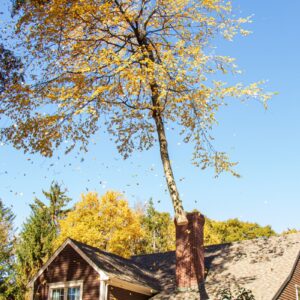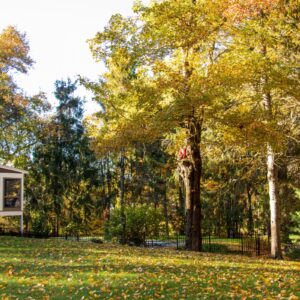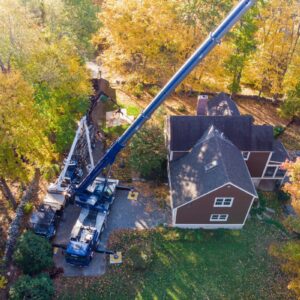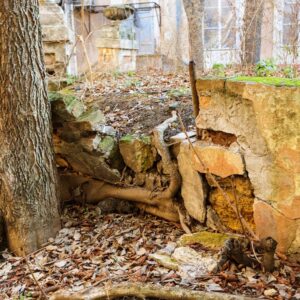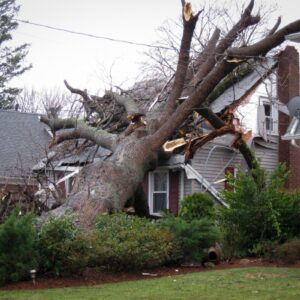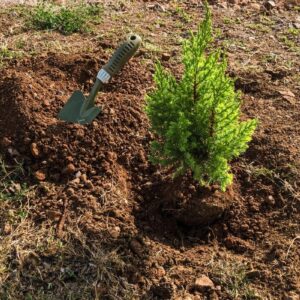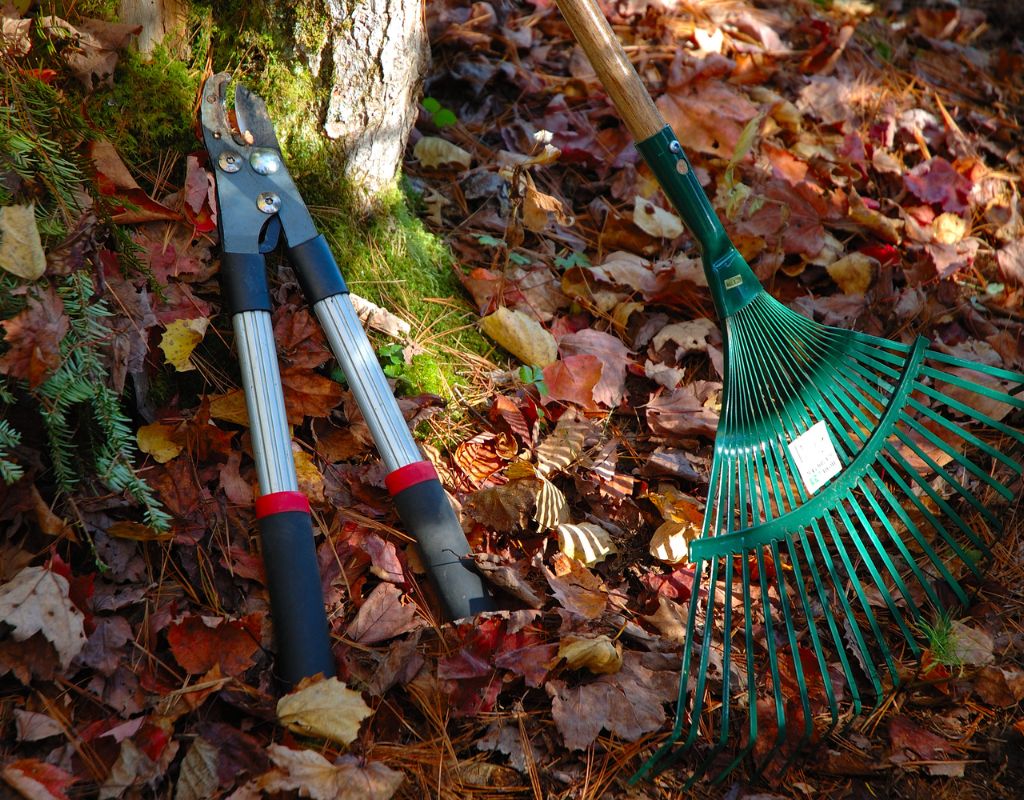Massachusetts sees more lightning than any other New England state (with 1,267,046 lightning pulses yearly). Most people worry about strikes hitting their homes, but when lightning hits a tree, they are just as vulnerable and often bear the brunt of the damage.
Key Takeaways
- Lightning targets trees because they’re tall, moisture-filled conductors, with oak, elm, and pine trees being the most susceptible species in MetroWest, Massachusetts.
- Lightning damage can range from surface bark cracks to complete tree destruction, but internal damage may take weeks to fully appear, so avoid making immediate removal decisions.
- Many trees struck by lightning can survive with proper care; wait 2-6 months before major pruning or removal to see how the tree recovers naturally.
- After a lightning strike, reduce tree stress through proper watering, fertilizing, and mulching while monitoring for signs of decline like discolored leaves, peeling bark, or increased insect activity.
- Corrective pruning may be able to restore your tree after a lightning strike, but you should remove any dead trees for safety.

Lightning strikes behind a tree on a stormy night in Westborough, MA.
Why Trees Get Struck by Lightning
Trees are some of the most common victims of lightning strikes, especially during summer storms here in Massachusetts. That’s because they’re often the tallest objects in a landscape, making them an easy path for lightning to reach the ground.
But height isn’t the only factor. Trees are filled with moisture – from sap in the trunk to water in the leaves – and that moisture conducts electricity. So, when lightning hits, it travels through the water-filled cells, often causing serious internal and external damage.
Some species are also more likely to be struck than others. Tall, moisture-rich trees, like oak, pine, maple, and elm, tend to be hit more often, particularly if they stand alone in an open area or near a structure.
What Happens When Lightning Strikes a Tree?
Lightning reaches extremely high temperatures, as it can pass through the air at 50,000 degrees Fahrenheit. To put that into perspective, that is about five times as hot as the surface of the sun. So, when lightning strikes a tree, it can obviously do significant damage.
As soon as lightning strikes the tree, water in its cells can boil, causing steam to form. The expanding steam can explode, cracking bark or even stripping it off the tree.
Sometimes, a tree is only hit once. Other times, lightning strikes multiple times or travels in unpredictable paths. It might damage just a few limbs, or it could tear through the entire tree from top to bottom, all the way to the roots.
How to Tell If a Tree Was Struck by Lightning
Lightning damage isn’t always immediately obvious. What you see on the surface depends on how the lightning traveled through the tree. Still, there are a few telltale signs to watch for:
- Long cracks running down the trunk
- Bark that’s peeling, missing, or blown off
- Sudden loss of leaves (defoliation)
- Signs of decline in the weeks or months that follow
- A tree that suddenly dies
Keep in mind that some of the most serious damage happens inside the tree, beneath the bark and below the soil. It can take days or even weeks for internal damage to show. That’s why it’s important not to rush into pruning or removal. Give the tree time to respond and then consult a tree service to assess the damage and determine the next best steps.
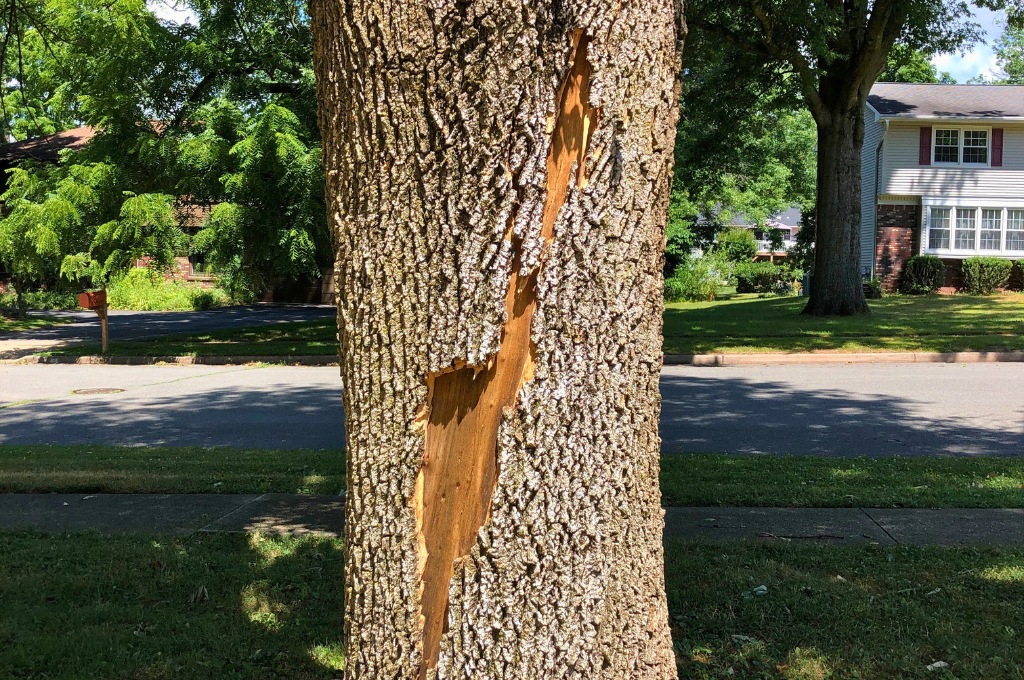
An ash tree showing bark damage from a lightning strike. Photo by Famartin, CC BY-SA 4.0, via Wikimedia Commons
How to Help a Tree Recover After a Lightning Strike
A lightning strike doesn’t always mean your tree is a goner. In fact, many trees survive the initial hit – what kills them is the stress and secondary damage that follows. That’s why the goal in the first few weeks is to support recovery and reduce additional stress.
Here are some simple ways to give your tree the best shot at survival:
- Water your tree if there has not been sufficient rainfall in recent weeks
- Fertilize the tree if there is a nutrient deficiency
- Add mulch around your trees to protect against heat stress
- Monitor closely for signs of insects or disease
Wait Before Pruning
You can prune a tree after a lightning strike but limit it to branches that are obviously dead or broken and at risk of falling. Overpruning at this stage can cause additional stress to your trees as they attempt to recover from the lightning strike. Give your tree two to six months to show signs of how it’s handling the damage.
Once it’s clearer what parts of the tree have survived, you can schedule corrective pruning from a professional crew to remove damaged limbs and reduce structural stress. This will support the weaker sections of your tree and lower the risk of further complications and failure.
PRO TIP: Trying to prune these trees yourself is incredibly dangerous and could result in an injury or damage to your property.
When to Remove a Tree Struck by Lightning
After a lightning strike, the big question is whether a tree can be saved or does it need to be removed. In some cases, the answer is clear, but in others, it may take months to know for sure.
Before making any decisions, it’s best to consult with a Certified Arborist who can assess the tree’s structural integrity, health, and long-term viability. Some trees can bounce back with time and care, while others quickly become safety hazards that need to come down.
Here’s when removal is usually the safest choice:
- Tree Has Split: If lightning causes the trunk or major limbs to crack or split, the tree likely can’t be saved. These structural failures make it unstable and dangerous.
- Deep Vertical Cracks in the Trunk: These cracks weaken the tree and open it to decay. If the tree is near a house, driveway, or well-traveled area, removal is often the right choice.
- Tree is Dead: Some trees decline slowly after a strike, while others die quickly. Once a tree is dead, it becomes brittle and unpredictable – and much more hazardous to remove. Don’t wait.
- Tree is a Liability Due to Location: Even a tree that appears stable can pose a serious risk if it’s leaning over your home, garage, or a public walkway. Damaged trees in high-traffic areas often need to come down before they become an emergency.
PRO TIP: Always have a professional handle tree removal – especially for large, dead, or storm-damaged trees. Dead trees are dangerous to work with and often require equipment like a tree removal crane. American Climbers has the equipment and extensive experience to remove hazardous trees safely and efficiently.
Frequently Asked Questions About Lightning Damage to Trees
As we prepare for future storms and lightning in the MetroWest area, it’s vital to know how to protect and treat your trees. Some of the answers to your frequently asked questions about lightning damage to trees include:
How soon after a storm should I call a tree service about my tree struck by lightning?
We recommend giving us a call as soon as you determine your tree has suffered a lightning strike. The sooner we can take a look at it, the quicker we can get you a diagnosis of its condition and the chances it has to survive.
Are some trees more likely to suffer from lightning strikes?
Some trees are more likely to be struck by lightning than others, including many popular species in the MetroWest area. According to the International Society of Arboriculture, the top ten trees most likely to suffer from a lightning strike, in order, are:
- Oak
- Elm
- Pine
- Tulip tree
- Poplar
- Ash
- Maple
- Sycamore
- Hemlock
- Spruce
What are the warning signs that a lightning-struck tree is declining?
Some of the signs to look for that indicate a lightning-struck tree is continuing to decline include:
- Discolored leaves
- Bark that continues to peel
- Increased insect activity around your tree
- Mushrooms growing on your tree
- Branch dieback
- Expanding cracks
If you notice these signs, have a tree service examine your trees and see if removal is the best option.
Do trees attract lightning?
While trees do not specifically attract lightning, they are more prone to lightning strikes. This is because trees are often the tallest objects in your yard and because their internal moisture and sap are good conductors of electricity.
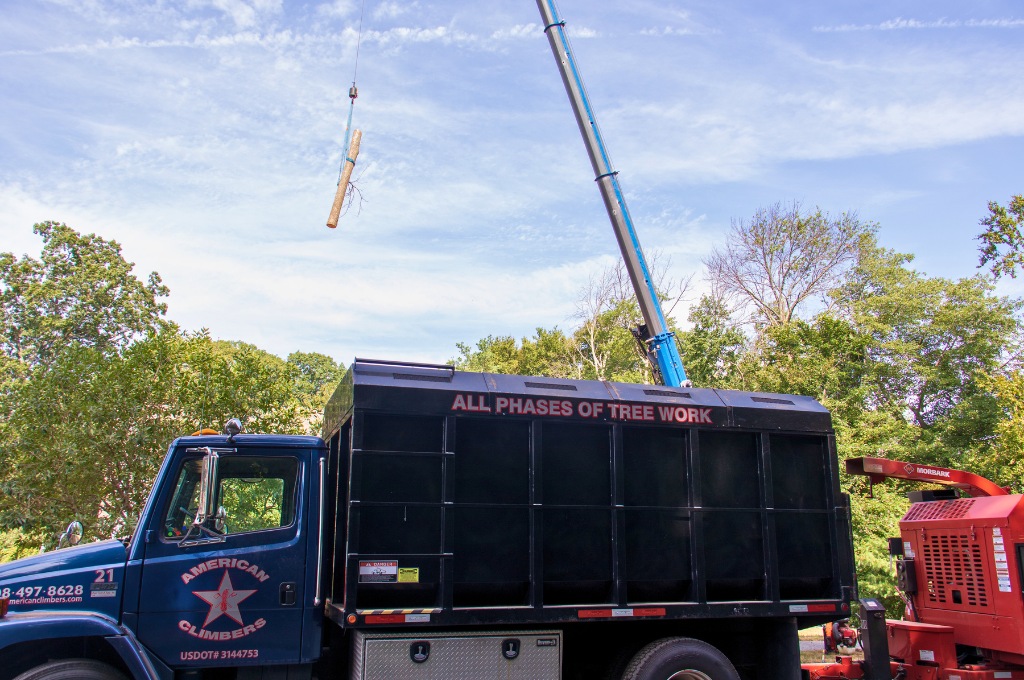
The American Climbers crane lifting a piece of a dead tree during tree removal in Framingham, MA.
Tree Struck by Lightning? Let American Climbers Handle It Safely and Professionally
After a storm, you have a lot to worry about – from damage to your home, power outages, and more. But your trees could be in trouble, too. A lightning strike can severely injure or even kill your tree, and waiting too long to act can make things worse. Whether your tree has a chance to recover or needs to come down, our team can help you make the right call.
At American Climbers, we’ve been safely pruning and removing storm-damaged trees across the MetroWest for decades. We’ll assess the damage, walk you through your options, and take care of the hard work – all with safety, efficiency, and expert care.
Call us today at 508-497-8628 or request a quote online.
Blog Topics
Recent Posts
What's Happening? Stay Informed!
Stay on top of local events, pest and disease updates, tree and landscape tips, and more. Delivered straight to your inbox each month.

